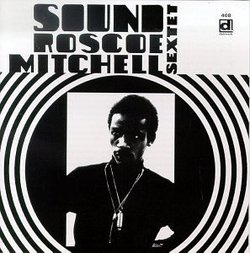A Must!
riot67 | detroit | 05/11/2000
(5 out of 5 stars)
"This lp released in 1966 is a monumental effort. Not only is it the first recorded music to emerge from the groundbreaking AACM it changed the face of free jazz and sent it into new and unexplored territory that would be further expanded on by The Art Ensemble of Chicago and Anthony Braxton among others. At any rate "Sound" is essentially an Art Ensemble....recording minus Joseph Jarman. The cd issue contains alternate cuts of "Ornette" and the two versions of "Sound" are seperated. On "Ornette" Mitchell pays homage to the master; high energy Ornette inspired tonal jazz, music that bombards from all sides. On "Sound" the breakthrough on this album the musicans alternate soloing interspaced with periods of silence. At times the intruments wail over crashing cymbals and other times they cry as if in agony. A very moving experience indeed. The piece is not without structure though, there is a method to Mitchells madness. The "Little Suite" employs the various little instruments that later became a signature for the Art Ensemble of Chicago. All in all this is a landmark recording and deserves to be on the same shelf as Colemans "Free Jazz" and Coltranes "Acension". Mitchell has never ceased to amaze both as a muscian but more importantly as a composer and this is an important record that both documents the beginning of Mitchells career as well as The Art Ensemble of Chicago."
A lesser-known early template for free jazz
R. Hutchinson | a world ruled by fossil fuels and fossil minds | 06/27/2005
(5 out of 5 stars)
"After the manic energy of Ornette Coleman, Cecil Taylor, Albert Ayler, and the late Coltrane, SOUND introduced an entirely different approach to the developing free jazz avant-garde -- the deliberate use of space and the elimination of the pulse. Of course, this was not accepted within the parameters of "jazz" by many, but it shared that fate with all of the above-mentioned innovators. Though I know Mitchell has denied the connection, his sound innovations created common ground with the European avant-garde in the form of improvising groups like AMM and the Spontaneous Music Ensemble (which included Evan Parker), as well as the experimentalists of the classical tradition.
This recording of Roscoe Mitchell's compositions was the first recording by the new AACM, Chicago's Association for the Advancement of Creative Musicians, which at first centered around pianist and composer Muhal Richard Abrams. Robert Koester's Delmark label was important in documenting the AACM in those early years, recording Abrams, Anthony Braxton, and others. This delmark CD reissue, from 1996, the 30th year anniversary of the original recording, is a remarkable expansion of the original vinyl edition. First, an alternate recording of "Ornette" is added. Second, the original "Sound," as it turns out, was a splice from two recordings -- here we are presented with both versions in their entirety, one 26'26, and the other 19'20. "Ornette" is the most conventional of the three compositions, and serves as a gateway into the realm of pure sound abstraction of the title track. "The Litte Suite," which introduced what became a core element of the Art Ensemble's repertoire in later years, a bewildering battery of little percussion instruments, whistles, harmonicas, and so forth, brings a humorous note, which would also become so key to the AEC sound palette.
SOUND is attributed to the Roscoe Mitchell Sextet, but it already features Malachi Favors on bass and Lester Bowie on trumpet. Joseph Jarman would soon join Mitchell, Favors & Bowie in what was originally called Roscoe Mitchell's Art Ensemble. They left for Paris in 1969, where Don Moye joined, and "Chicago" was added, and the Art Ensemble of Chicago was born.
SOUND may not be as well-known as Ornette's THE SHAPE OF JAZZ TO COME, or Coltrane's A LOVE SUPREME. It may be only slightly more obscure than Cecil's UNIT STRUCTURES, come to think of it. But the point is, it should be more widely known -- it's not easy listening music, it is a voyage into the unknown. It represents the creative spirit of music at its best.
See my AACM -- THE CHICAGO AVANT-GARDE list for more recordings and reviews."
More Than Just Historic
MF | Chicago | 02/02/2006
(5 out of 5 stars)
"Yes, this is a historic recording--the first AACM recording, but more importantly, Mitchell's record is an amazing set of music by some very original and creative musicians.
There are two versions of "Ornette", an aptly named short piece that does indeed owe more than a little to Ornette Coleman. However, the focus here is on the highly original title track. As others have noted, on this cd issue we are treated to the two full versions of this track. Although the title is "Sound", silence is equally important here, as the musicians examine the notes and the spaces between them. The ensemble playing shows some traces of free jazz, some traces of third stream, but ultimately is a highly original work that continues to fascinate four decades later.
For any lover of creative jazz players of this era, this album is no less than essential."


 Track Listings (5) - Disc #1
Track Listings (5) - Disc #1